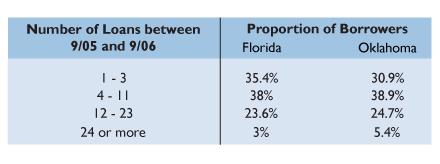Finance & Accounting Social Impact Economics Dec 23, 2009
The Real Costs of Credit Access
Evidence from the payday lending market
Cheap credit helped define the go-go years of the 2000s. Banks advertised historically low rates, Web sites sprang up competing for a piece of the pie, and automobiles could be bought with little to no interest whatsoever. Those with polished credit scores could be flush with borrowed money if they chose. But on the other side of the financial landscape, a different lender flourished—payday loan stores, a source of credit virtually unheard of twenty years ago. By 2006 there were more than 25,000 payday loan stores in the United States. The industry’s growth has both its supporters and detractors, and depending on who you ask, credit for the less-than-creditworthy is either an equitable source of money in hard times or a leech that drains the assets of the poor.
Many of the arguments for and against payday lending are anecdotal, and there are relatively few rigorous studies examining the claims and counterclaims. Payday loans are often positioned as a way to surmount temporary financial hardships, but they come with a steep cost. Annualized interest rates in the form of fees are often 400 percent or more. Payday lenders argue that such exorbitant fees are necessary given the default rate of these loans and that their services extend credit to an underserved portion of society. But payday loans may not be advantageous for many who use them, according to research by Brian Melzer (Assistant Professor of Finance at the Kellogg School of Management).
Melzer dug into the anecdotes surrounding the payday lending industry, investigating whether short-term, high-interest loans can help hard-up households deal with financial distress by enabling them to make their mortgage, rent, or utility payments. He also tested to see whether households with access to payday loans skipped meals or delayed health care.
“When households have better access to payday loans, I find no evidence that they are less likely to report distress,” Melzer says. “In fact, I find the opposite effect. Households are more likely to report distress when they have better access to payday loans.”
Payday loan access exacerbated rather than ameliorated financial hardship for many of the households in Melzer’s study—paying mortages, phone and utility bills, rent, and medical bills all became more difficult.
One Boom Leads to Others’ Ruin
The payday lending industry has experienced growth like few others, lending just $8 billion in 1999 and more than $40 billion five years later. Many store operators started out as check-cashing outfits, allowing people without bank accounts to cash their paychecks for a fee. Historically that was the extent of their services, as payday loans were legally ambiguous. This uncertainty kept larger, more risk-averse firms on the sidelines. But many states clarified their laws and regulations in the 1990s, allowing lenders to sidestep usury laws (if any) in a variety of ways. Most payday loans carry $15 to $20 in fees per $100 of principal balance and have short terms (two to four weeks). Loaned amounts typically range between $200 and $1,000. When applying, borrowers present a pay stub along with a postdated check for the principal plus any fees, which the lender will cash if the borrower fails to repay the loan at maturity.
The majority of payday borrowers are not, in fact, destitute. “Very-low-income people don’t borrow at payday loan stores—they’re screened out of the market,” notes Melzer. People who earn between $15,000 and $50,000 a year are most likely to take out a payday loan, especially if they lack access to traditional credit. Below that threshold, lenders would be hard-pressed to make any money—the default rate would be too high.
Investigating the pros and cons of payday lending is fraught with difficulty due to a variety of confounding factors. One approach has been to study households in states with different stances on payday lending. But just as regulations vary across state lines, so to do socioeconomic conditions, labor markets, and social welfare programs. Rather than simply compare two or more states, Melzer divided up the populations within individual states, grouping households according to their ease of access to payday lending. To determine when and where households reported financial distress, he used data from the National Survey of American Families. If payday lending had an impact on household finances, he reasoned, it should show up in those households with easier access to payday lending—that is, those close to the border of a payday-permissive state.
“If you look at the portion of the state where people can easily travel across the border at a fairly low cost to get a loan,” Melzer says, “people who are in these border areas with payday loan states report higher rates of distress.” Melzer also discovered there were plenty of stores in those border regions to take advantage of the broader customer base. Overall, there were 16 percent more stores in zip codes bordering payday-prohibitive states. The density was even higher in areas where more of the neighboring population made between $15,000 and $50,000—the earning range of most payday borrowers.
Shifting regulations also allowed Melzer to investigate varying degrees of payday access in the northeastern United States between 1997 and 2001. Payday lending emerged in Delaware, Pennsylvania, New Hampshire, and Rhode Island at different times: it appeared in Delaware in 1997 and Pennsylvania in 1998. New Hampshire waited until 2000 to legalize the practice, while Rhode Island followed in 2001. The neighboring states of Massachusetts, New Jersey, and New York prohibited the loans throughout the study period. If payday lending were beneficial or detrimental, Melzer expected to see corresponding changes in border households’ finances as the practice was legalized—applying for a loan would only require a trip to the permissive neighboring state. Melzer suspected those closer to the border of the newly permissive states would be more likely to make the journey, as were those who commuted across state lines for work.
Melzer’s study narrowed in on two possible scenarios to further examine payday lending’s effects. If payday lending had no influence, the relative rate of hardship should be equal between both border and inland households in the $15,000 to $50,000 stratum. Payday lending would be similarly absolved if the difference in hardship rates between impoverished and low- to middle-income border households remained constant when regulations changed across the state line.
The evidence did not favor payday lending, however. Melzer found that low- to middle-income households with access to payday loans were more likely to fall on hard times. They were 7 percent more likely to skip meals, 25 percent more likely to have difficulty paying bills, and 40 percent more likely to drop phone service. They were also 60 percent more likely to move out of their home and 25 percent more likely to delay medical care.
Questionable Credit
Melzer’s findings raise a few questions about credit access for households with substandard credit ratings. Just as the subprime mortgage crisis has inspired Congress to examine lending practices, states have been actively revisiting their statutes on loans, fees, and interest rates. “In many cases, states are explicitly legislating whether it’s legal to make a payday loan or not,” Melzer says.
Some states, such as Illinois, have taken a different tack, instead choosing to limit the number of times a person can take out a payday loan rather than ban the practice outright. Statistics from Florida and Oklahoma support such regulations—nearly 40 percent of payday borrowers take out four to eleven loans per year, while nearly 25 percent take out twelve to twenty-three loans per year (Figure 1). Limiting per-person loan numbers could be a viable solution, Melzer thinks. “It’s not perfect, but there might be some way we can target and restrict access among these types of users that experience this harm while still allowing others that use the loan to substitute away from more expensive credit” like a high late fee for a credit card, he says.

Figure 1: Payday borrowing data from Florida and Oklahoma
While Melzer is not advocating the banning of payday lending completely—for some, one or two payday loans can be beneficial—he does think policy makers need to reexamine to whom they should be offered. “There are some people who don’t benefit from having better access to credit.”
Melzer, Brian. 2011. The real costs of credit access: Evidence from the payday lending market. Quarterly Journal of Economics, February, 126(1): 517-555.


